Spatial–Temporal Distribution Characteristics of the Water Footprint and Water-Saving Potential of Fruit Trees in Tarim River Basin
Abstract
1. Introduction
2. Materials and Methods
2.1. Study Area
2.2. Study Data
2.2.1. Agricultural Production Data
2.2.2. Water Resource Data
2.2.3. Basic Geographic Information and Data
2.2.4. Meteorological Data
2.2.5. Data Processing
2.3. Calculation Methods
WF Calculation
3. Results
3.1. Analysis of Planting Area and Yield of Main Fruit Trees in Five Prefectures of TRB
3.2. Temporal and Spatial Evolution of WF
3.2.1. Change in Meteorological Parameters
3.2.2. Interannual Variation in WF
3.2.3. Spatial Evolution of WF
3.3. Analysis of Water-Saving Potential Under Complete Drip Irrigation Technology
4. Discussion
4.1. Spatial and Temporal Evolution of the WF
4.2. Application of Drip Irrigation Technology to Reduce the WFblue of Forests and Fruit Trees in TRB
4.3. Suggestion
5. Conclusions
Author Contributions
Funding
Data Availability Statement
Acknowledgments
Conflicts of Interest
References
- Fang, G.; Chen, Y.; Li, Z. Variation in agricultural water demand and its attributions in the arid Tarim River Basin. J. Agric. Sci. 2018, 156, 301–311. [Google Scholar] [CrossRef]
- Wang, F.; Chen, Y.; Li, Z.; Fang, G.; Li, Y.; Xia, Z. Assessment of the irrigation water requirement and water supply risk in the Tarim River Basin, Northwest China. Sustainability 2019, 11, 4941. [Google Scholar] [CrossRef]
- Wang, F.; Wu, Z.-p.; Wang, Y.; Jiao, W.; Chen, Y.-n. Dynamic monitoring of desertification in the Tarim Basin based on RS and GIS techniques. Chin. J. Ecol. 2017, 36, 1029. [Google Scholar]
- Raluy, R.G.; Quinteiro, P.; Dias, A.C. Water footprint of forest and orchard trees: A review. Water 2022, 14, 2709. [Google Scholar] [CrossRef]
- Quinteiro, P.; Ridoutt, B.G.; Arroja, L.; Dias, A.C. Identification of methodological challenges remaining in the assessment of a water scarcity footprint: A review. Int. J. Life Cycle Assess. 2018, 23, 164–180. [Google Scholar] [CrossRef]
- Taylor, N.J.; Gush, M.B. The Water Use of Selected Fruit Tree Orchards (Volume 1): Review of Available Knowledge. Water Research Commission Report 14. 2014. Available online: https://www.wrc.org.za/wp-content/uploads/mdocs/1770-1-141.pdf (accessed on 1 August 2024).
- Nisbet, T.R.; Andreucci, M.-B.; De Vreese, R.; Högbom, L.; Kay, S.; Kelly-Quinn, M.; Leonardi, A.; Lyubenova, M.I.; Pol, P.O.; Quinteiro, P. Forest Green Infrastructure to Protect Water Quality: A Step-by-Step Guide for Payment Schemes, Green Infrastructure and Climate Change Adaptation: Function, Implementation and Governance; Springer Nature Singapore: Singapore, 2022; pp. 105–131. [Google Scholar]
- Bazrafshan, O.; Etedali, H.R.; Moshizi, Z.G.N. Water Footprint of Fruits in Arid and Semi-Arid Regions, Environmental Footprints of Crops; Springer: Berlin/Heidelberg, Germany, 2022; pp. 1–26. [Google Scholar]
- Li, F.; Yuan, C.; Lao, D.; Yao, B.; Hu, X.; You, Y.; Wang, L.; Sun, S.; Liang, X. Drip irrigation with organic fertilizer application improved soil quality and fruit yield. Agron. J. 2020, 112, 608–623. [Google Scholar] [CrossRef]
- Li, Z.; Zong, R.; Wang, T.; Wang, Z.; Zhang, J. Adapting root distribution and improving water use efficiency via drip irrigation in a jujube (Zizyphus jujube Mill.) orchard after long-term flood irrigation. Agriculture 2021, 11, 1184. [Google Scholar] [CrossRef]
- Pfister, S.; Koehler, A.; Hellweg, S. Assessing the environmental impacts of freshwater consumption in LCA. Environ. Sci. Technol. 2009, 43, 4098–4104. [Google Scholar] [CrossRef]
- Zhuo, L.; Mekonnen, M.M.; Hoekstra, A.Y. The effect of inter-annual variability of consumption, production, trade and climate on crop-related green and blue water footprints and inter-regional virtual water trade: A study for China (1978–2008). Water Res. 2016, 94, 73–85. [Google Scholar] [CrossRef]
- Hossain, I.; Imteaz, M.A.; Khastagir, A. Water footprint: Applying the water footprint assessment method to Australian agriculture. J. Sci. Food Agric. 2021, 101, 4090–4098. [Google Scholar] [CrossRef]
- Gush, M.; Dzikiti, S.; van Der Laan, M.; Steyn, M.; Manamathela, S.; Pienaar, H. Field quantification of the water footprint of an apple orchard, and extrapolation to watershed scale within a winter rainfall Mediterranean climate zone. Agric. For. Meteorol. 2019, 271, 135–147. [Google Scholar] [CrossRef]
- Shen, Y.; Li, S.; Chen, Y.; Qi, Y.; Zhang, S. Estimation of regional irrigation water requirement and water supply risk in the arid region of Northwestern China 1989–2010. Agric. Water Manag. 2013, 128, 55–64. [Google Scholar] [CrossRef]
- Yu, J.; Long, A.; Deng, X.; He, X.; Zhang, P.; Wang, J.; Hai, Y. Incorporating the red jujube water footprint and economic water productivity into sustainable integrated management policy. J. Environ. Manag. 2020, 269, 110828. [Google Scholar] [CrossRef]
- Aldaya, M.M.; Garrido, A.; Llamas, R. Water footprint and virtual water trade: The birth and growth of a new research field in Spain. Water 2020, 12, 2641. [Google Scholar] [CrossRef]
- Imbernón-Mulero, A.; Martínez-Alvarez, V.; Ben Abdallah, S.; Gallego-Elvira, B.; Maestre-Valero, J.F. A Comparative Water Footprint Analysis of Conventional versus Organic Citrus Production: A Case Study in Spain. Agriculture 2024, 14, 1029. [Google Scholar] [CrossRef]
- Kahramanoğlu, İ.; Usanmaz, S.; Alas, T. Water footprint and irrigation use efficiency of important crops in Northern Cyprus from an environmental, economic and dietary perspective. Saudi J. Biol. Sci. 2020, 27, 134–141. [Google Scholar] [CrossRef] [PubMed]
- Lu, Q.; Liu, F.; Li, Y.; Wang, D. Study on the relationship between water resources utilization and economic growth in tarim river basin from the perspective of water footprint. Water 2022, 14, 1655. [Google Scholar] [CrossRef]
- Zamani, A.; Rostamian, R.; Norouzi, G. Comparative assessment of environmental impacts and water scarcity footprint of horticultural crops in Iran. Environ. Res. 2024, 257, 119082. [Google Scholar] [CrossRef]
- Rouzi, A.; Halik, Ü.; Thevs, N.; Welp, M.; Aishan, T. Water Efficient Alternative Crops for Sustainable Agriculture along the Tarim Basin: A Comparison of the Economic Potentials of Apocynum pictum, Chinese Red Date and Cotton in Xinjiang, China. Sustainability 2017, 10, 35. [Google Scholar] [CrossRef]
- Feng, M.; Chen, Y.; Li, Z.; Duan, W.; Zhu, Z.; Liu, Y.; Zhou, Y. Optimisation model for sustainable agricultural development based on water-energy-food nexus and CO2 emissions: A case study in Tarim river basin. Energy Convers. Manag. 2024, 303, 118174. [Google Scholar] [CrossRef]
- Hoekstra, A.; Chapagain, A.K.; Aldaya, M.M.; Mekonen, M.M. The Water Footprint Assessment Manual: Setting the Global Standard; Routledge: London, UK, 2012. [Google Scholar]
- González Perea, R.; García Morillo, J.; Rodríguez Díaz, J.A.; Barrios, P.M.; Poyato, E.C. Water Footprint Accounting for Improving Irrigation Management in Olive Trees. In Water Scarcity and Sustainable Agriculture in Semiarid Environment; Academic Press: Cambridge, MA, USA, 2018; pp. 61–72. [Google Scholar]
- Esetlili, M.T.; Serbeş, Z.A.; Çolak Esetlili, B.; Kurucu, Y.; Delibacak, S. Determination of Water Footprint for the Cotton and Maize Production in the Küçük Menderes Basin. Water 2022, 14, 3427. [Google Scholar] [CrossRef]
- Wang, D.; Hubacek, K.; Shan, Y.; Gerbens-Leenes, W.; Liu, J. A Review of Water Stress and Water Footprint Accounting. Water 2021, 13, 201. [Google Scholar] [CrossRef]
- Mekonnen, M.M.; Hoekstra, A.Y. Sustainability of the blue water footprint of crops. Adv. Water Resour. 2020, 143, 103679. [Google Scholar] [CrossRef]
- Bazrafshan, O.; Zamani, H.; Ramezani Etedali, H.; Dehghanpir, S. Assessment of citrus water footprint components and impact of climatic and non-climatic factors on them. Sci. Hortic. 2019, 250, 344–351. [Google Scholar] [CrossRef]
- Song, M.; He, W.; An, M.; Fang, X.; Wang, B.; Ramsey, T.S. Toward better agricultural grey water footprint allocation under economy-resource factors constraint. Ecol. Indic. 2023, 154, 110806. [Google Scholar] [CrossRef]
- Machin Ferrero, L.M.; Araujo, P.Z.; Valdeon, D.H.; Nishihara Hun, A.L.; Mele, F.D. Water footprint of lemon production in Argentina. Sci Total Env. 2022, 816, 151614. [Google Scholar] [CrossRef]
- Cao, X.; Bao, Y.; Li, Y.; Li, J.; Wu, M. Unravelling the effects of crop blue, green and grey virtual water flows on regional agricultural water footprint and scarcity. Agric. Water Manag. 2023, 278, 108165. [Google Scholar] [CrossRef]
- Harris, F.; Moss, C.; Joy, E.J.M.; Quinn, R.; Scheelbeek, P.F.D.; Dangour, A.D.; Green, R. The Water Footprint of Diets: A Global Systematic Review and Meta-analysis. Adv. Nutr. 2020, 11, 375–386. [Google Scholar] [CrossRef]
- Mekonnen, M.M.; Gerbens-Leenes, W. The Water Footprint of Global Food Production. Water 2020, 12, 2696. [Google Scholar] [CrossRef]
- Rockström, J.; Lannerstad, M.; Falkenmark, M. Assessing the water challenge of a new green revolution in developing countries. Proc. Natl. Acad. Sci. USA 2007, 104, 6253–6260. [Google Scholar] [CrossRef]
- Mekonnen, M.; Pahlow, M.; Aldaya, M.; Zarate, E.; Hoekstra, A. Sustainability, Efficiency and Equitability of Water Consumption and Pollution in Latin America and the Caribbean. Sustainability 2015, 7, 2086–2112. [Google Scholar] [CrossRef]
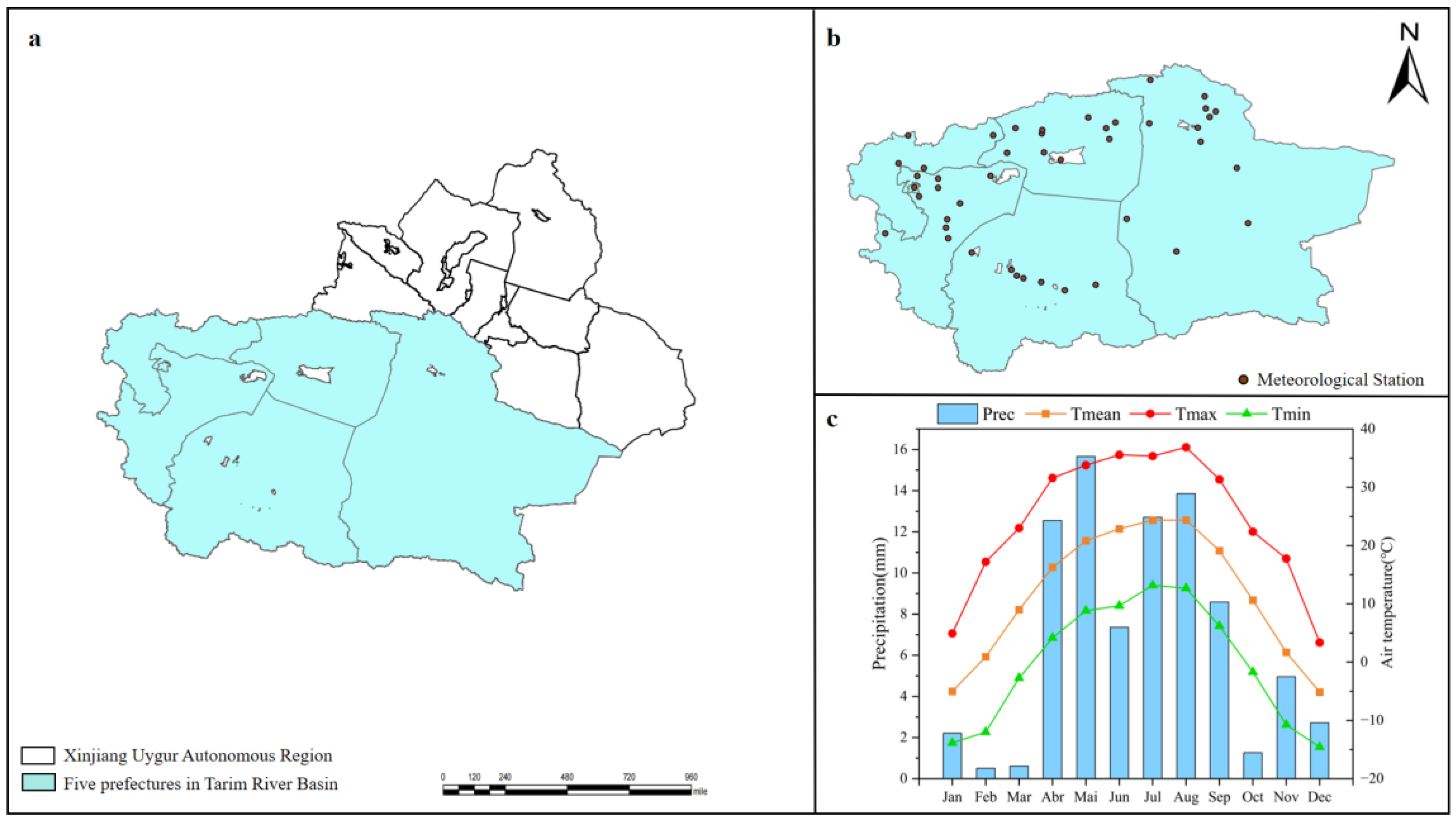
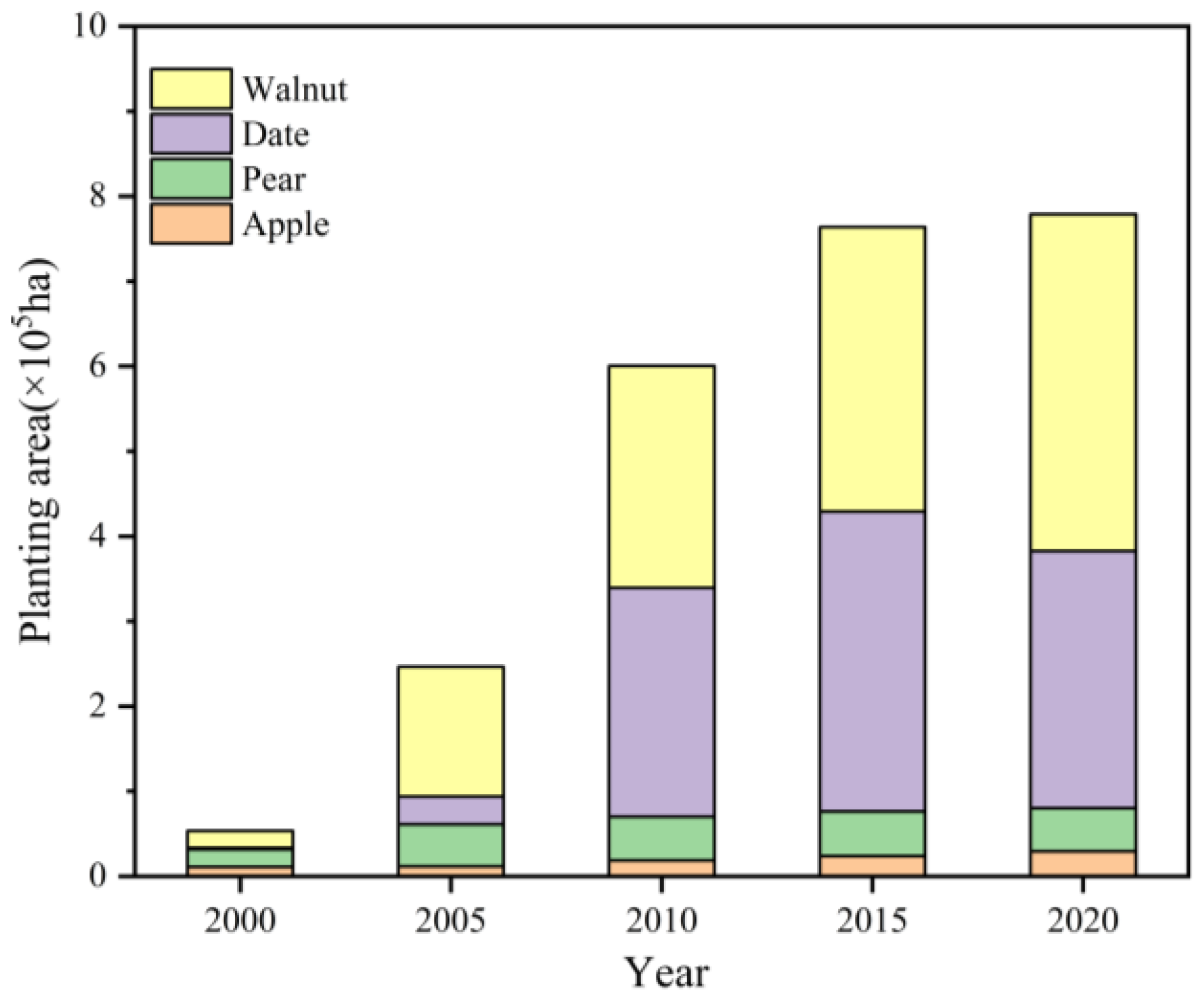
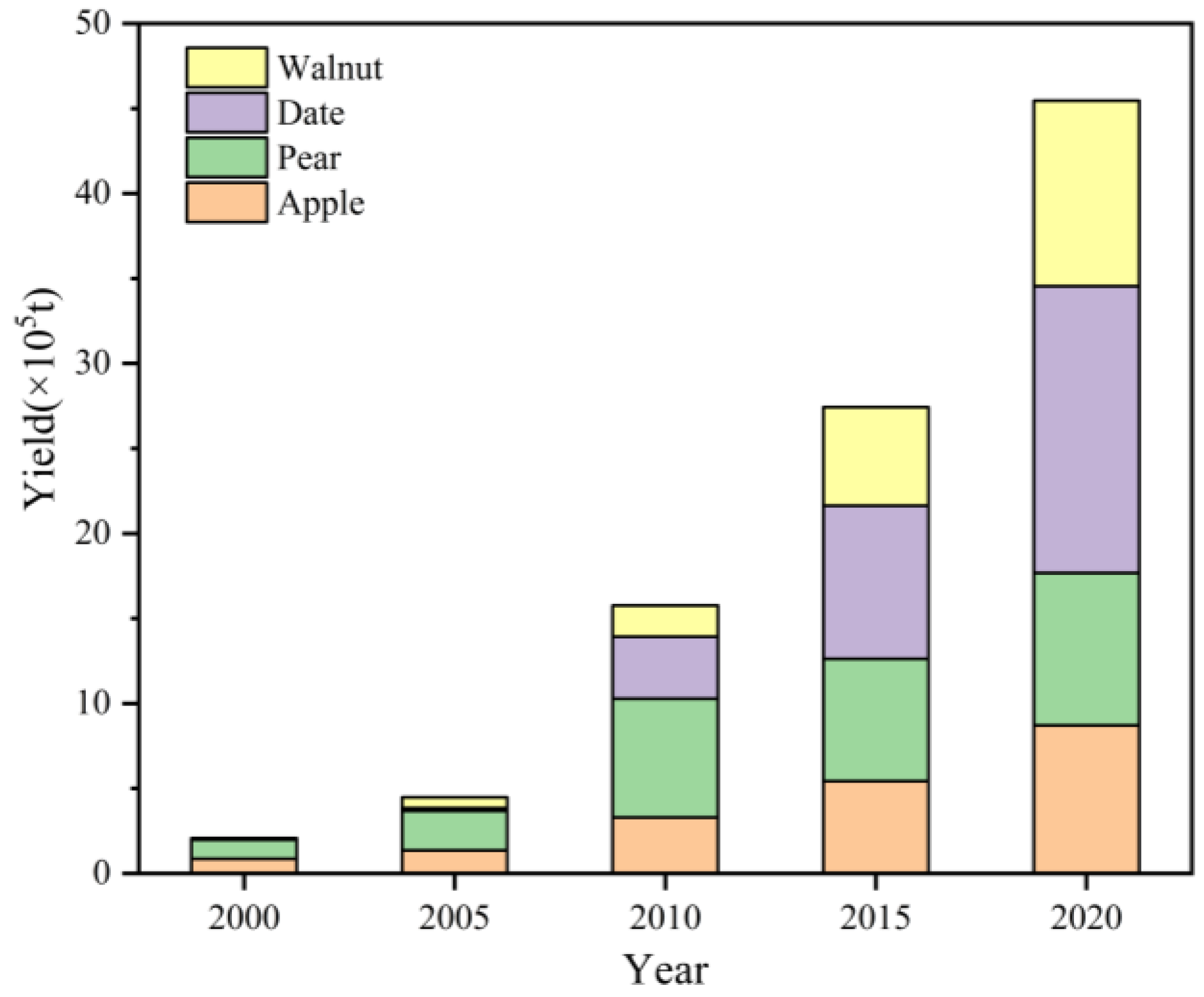
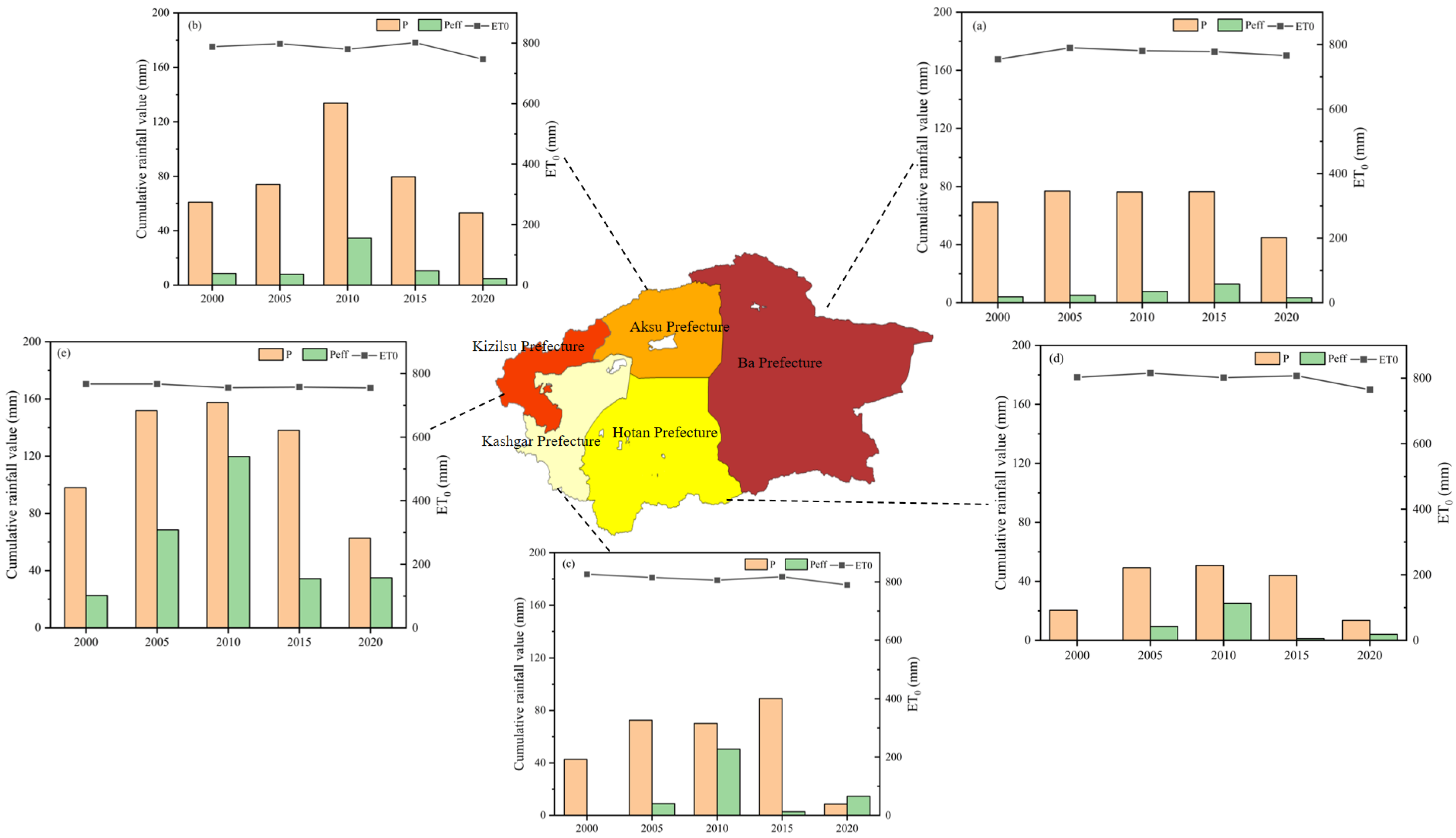

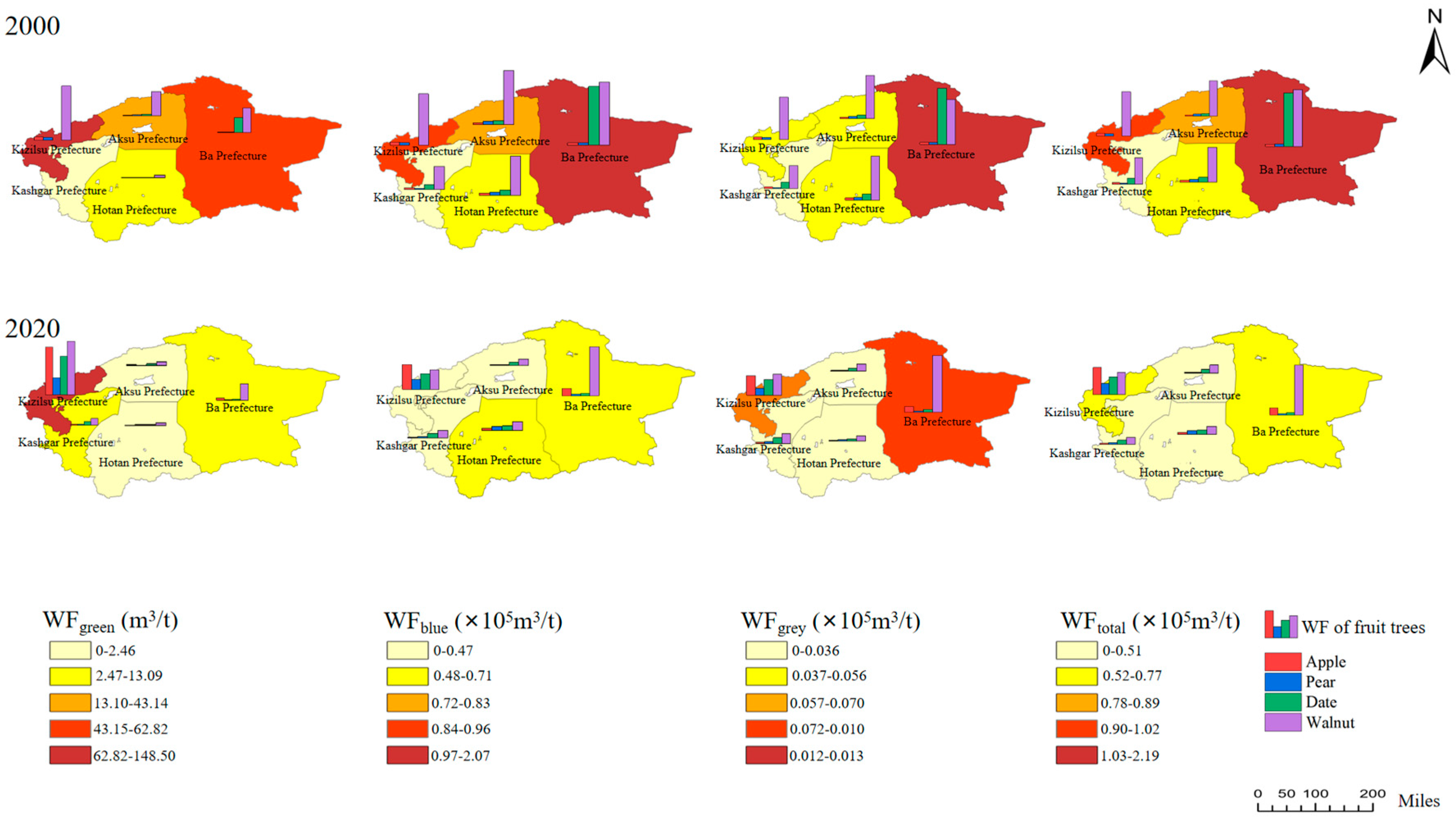

| Year | Apple | Pear | Date | Walnut |
|---|---|---|---|---|
| 2000 | 3577.55 | 3654.91 | 3567.83 | 3565.92 |
| 2005 | 3628.24 | 3710.43 | 3622.02 | 3597.38 |
| 2010 | 3574.51 | 3636.54 | 3549.58 | 3525.26 |
| 2015 | 3818.94 | 3683.55 | 3596.08 | 3595.12 |
| 2020 | 3669.25 | 3542.34 | 3458.47 | 3451.71 |
| Apple | Pear | Date | Walnut | Total | ||
|---|---|---|---|---|---|---|
| 2020 | Ba prefecture | 0.078 | 0.016 | 0.024 | 0.519 | 0.636 |
| Aksu prefecture | 0.005 | 0.005 | 0.021 | 0.040 | 0.072 | |
| Kizilsu prefecture | 0.211 | 0.085 | 0.133 | 0.165 | 0.595 | |
| Kashgar prefecture | 0.006 | 0.010 | 0.028 | 0.046 | 0.089 | |
| Hotan prefecture | 0.011 | 0.022 | 0.026 | 0.050 | 0.109 | |
| Total | 0.312 | 0.139 | 0.232 | 0.820 | 1.502 | |
| Applying complete drip irrigation technology in 2020 | Ba prefecture | 0.029 | 0.006 | 0.015 | 0.341 | 0.391 |
| Aksu prefecture | 0.002 | 0.003 | 0.012 | 0.017 | 0.034 | |
| Kizilsu prefecture | 0.082 | 0.038 | 0.078 | 0.064 | 0.262 | |
| Kashgar prefecture | 0.002 | 0.004 | 0.016 | 0.018 | 0.040 | |
| Hotan prefecture | 0.004 | 0.009 | 0.014 | 0.020 | 0.048 | |
| Total | 0.120 | 0.059 | 0.136 | 0.460 | 0.775 |
Disclaimer/Publisher’s Note: The statements, opinions and data contained in all publications are solely those of the individual author(s) and contributor(s) and not of MDPI and/or the editor(s). MDPI and/or the editor(s) disclaim responsibility for any injury to people or property resulting from any ideas, methods, instructions or products referred to in the content. |
© 2025 by the authors. Licensee MDPI, Basel, Switzerland. This article is an open access article distributed under the terms and conditions of the Creative Commons Attribution (CC BY) license (https://creativecommons.org/licenses/by/4.0/).
Share and Cite
Lin, X.; Chen, Y.; He, Z.; Li, M.; Ci, B.; Liu, Y.; Zhang, X.; Ma, F. Spatial–Temporal Distribution Characteristics of the Water Footprint and Water-Saving Potential of Fruit Trees in Tarim River Basin. Water 2025, 17, 1158. https://doi.org/10.3390/w17081158
Lin X, Chen Y, He Z, Li M, Ci B, Liu Y, Zhang X, Ma F. Spatial–Temporal Distribution Characteristics of the Water Footprint and Water-Saving Potential of Fruit Trees in Tarim River Basin. Water. 2025; 17(8):1158. https://doi.org/10.3390/w17081158
Chicago/Turabian StyleLin, Xinyuan, Yan Chen, Zheng He, Minghua Li, Baoxia Ci, Yang Liu, Xin Zhang, and Fuyu Ma. 2025. "Spatial–Temporal Distribution Characteristics of the Water Footprint and Water-Saving Potential of Fruit Trees in Tarim River Basin" Water 17, no. 8: 1158. https://doi.org/10.3390/w17081158
APA StyleLin, X., Chen, Y., He, Z., Li, M., Ci, B., Liu, Y., Zhang, X., & Ma, F. (2025). Spatial–Temporal Distribution Characteristics of the Water Footprint and Water-Saving Potential of Fruit Trees in Tarim River Basin. Water, 17(8), 1158. https://doi.org/10.3390/w17081158








